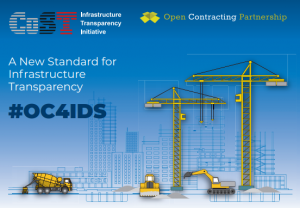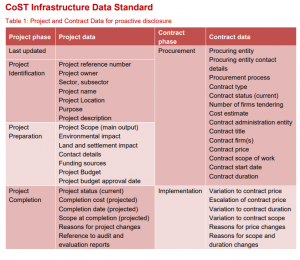Open Data Services has been working with with CoST and the Open Contracting Partnership to develop the Open Contracting for Infrastructure Data Standard (OC4IDS). This blog- originally published by Open Data Services on Medium – makes the case for an infrastructure transparency data standard, and dives into the existing standards the OC4IDS was built on.
Building a hospital, a railway, or a bridge is more complicated than just buying goods or services from a single supplier. Infrastructure projects often take years — if not decades — to plan and complete, and usually involve at least three separate contracts for design, construction and supervision.
This extra complexity makes it harder to get a complete picture of an infrastructure project from start to finish. At the same time, estimates suggest between 10–30% of investment is lost through inefficiency, mismanagement and corruption. Without access to good data on the complete lifecycle of an infrastructure project, it’s not  possible to understand these issues — let alone address them.
possible to understand these issues — let alone address them.
We developed the Open Contracting for Infrastructure Data Standard (OC4IDS) in partnership with experts from CoST — The Infrastructure Transparency Initiative and the Open Contracting Partnership.
In short, it’s a standard for joined-up data about infrastructure projects and contracts. It’s designed to make it easier to publish and use data, which in turn we hope will improve monitoring and scrutiny of infrastructure projects.
OC4IDS builds on experience working in many CoST member countries and the collaboration of the open contracting community.
We’ve recently released an update to the standard, so we’re publishing a series of blogs to document our work so far. In this part, we’re laying the foundations by making the case for an infrastructure transparency data standard, and explaining the two existing works that we’ve built on — the CoST Infrastructure Data Standard and the Open Contracting Data Standard.
What exactly do we mean by an infrastructure project?
In OC4IDS, an infrastructure project is defined as:
The development of a set of infrastructure assets in a specified location, generally the responsibility of a single procuring entity and budget authority: for example, a highway overpass or a university campus.
An infrastructure project can stand alone (e.g. a new hospital), or it can form part of a wider investment project or programme of work (e.g. a new rail station as part of an extension to a railway line).
Site survey: scoping the issues
The first phase in the development of OC4IDS was a research project to assess how easy it is to find and use data on infrastructure projects and contracts, including deep-dives into the available data in the UK and Ukraine.
We found that while data on infrastructure projects and contracts is published, it’s often scattered across disparate systems, agencies and departments. Data on projects and contracts needs to be manually matched, and there is a lack of project registers and identifiers.
As we’ve written about before, to be truly open, you need to standardise data. A standard helps to provide a common language for different stakeholders to understand and monitor infrastructure projects — or at least make definitions and assumptions explicit.
CoST Infrastructure Data Standard + Open Contracting Data Standard = OC4IDS
We identified the need for a data standard that brings together project-level information with information on multiple contracting processes to help drive better infrastructure for government, citizens and business. OC4IDS is built on two key foundations, the CoST Infrastructure Data Standard and the Open Contracting Data Standard.
CoST Infrastructure Data Standard
CoST — the Infrastructure Transparency Initiative is a global initiative that works with government, civil society and the private sector to increase the transparency and accountability of publicly funded infrastructure projects.
The CoST IDS provides a template list of requirements for disclosure at project and contract level. The standard is included as a key tool by the World Bank, Global Infrastructure Basel and Transparency International and has been applied in over 20 countries. Several CoST members have developed context specific laws and regulations that require the disclosure of information in accordance with the CoST IDS.
The CoST IDS defines the concepts which should be considered for disclosure, but it does not specify how the information should be structured, formatted or published.
Open Contracting Data Standard
The Open Contracting Data Standard (OCDS) is an open standard for the disclosure of contracting information, initially developed by Open Contracting Partnership in 2014. OCDS is now used by government agencies and civil society groups around the world to publish and analyse data on public contracts.
OCDS can be used to disclose joined-up data about all stages of a contracting process, from planning through to delivery and payment, but lacks a means to publish extensive data about the project a contracting process is part of.
OCDS specifies how the information should be structured, formatted or published, but only has a limited number of fields at the project level. This is because project level data — for example, environmental or land and settlement impact assessments — often exists independently of individual contracting processes.
OC4IDS
OC4IDS leverages both standards, by combining CoST’s work on what to disclose about infrastructure projects, with OCP’s work on what to disclose about contracting processes, and describes how to structure and format the data in a useful way.
OC4IDS provides a container to group the contracting processes that relate to particular infrastructure projects together, and a means to connect project level data to help get a clearer view of infrastructure transparency overall.
